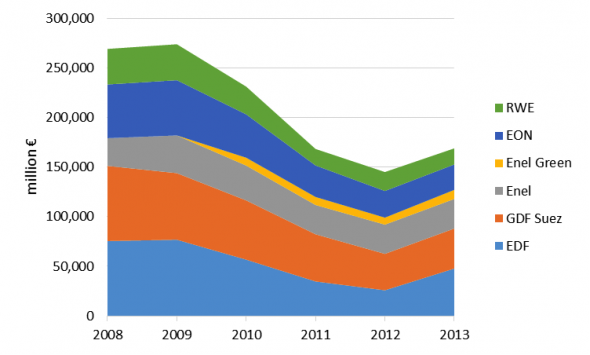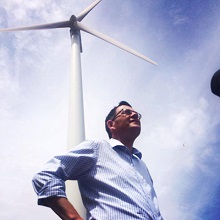- Victoria continues to be the country’s best location for renewable energy investment, thanks to planning changes which will streamline wind farm project approvals.
Applications made for new wind farms under the Andrews Labor Government will now be simpler, encouraging investment and jobs growth in regional areas.
In Victoria, we currently have 19 wind farms that have planning approval but are yet to be commissioned.
This pipeline of wind projects, if fully developed, will result in an estimated investment of just under $5 billion and support as many as 2,638 jobs throughout regional Victoria.
We’re also calling on the Federal Government to remove section 7c from the Renewable Energy (Electricity) Act 2000,which prevents State Governments from having their own schemes similar to the Renewable Energy Target (RET).
Tell Tony Abbott to let Victoria set its own renewable energy target www.thisislabor.org/vret
Meanwhile Alinta Energy may close its heavily polluting brown coal generators in Port Augusta within nine months. Close they certainly will. Giles Parkinson sees this as an opportunity for SA to shoot for 100% renewables.
Tony Abbott in an interview with Radio 2GB’s Alan Jones:
-
launched an extraordinary attack on wind farms in Australia, accusing them of having health impacts and describing them as “visually awful” – echoing similar comments by his Treasurer a year ago.
He also:
- declared the RET amendment for what it is – a “capital R” Reduction, aimed specifically at limiting the growth rate of the wind energy sector “as much as the current Senate would allow.”
Internationally the Abbott Government has been pretending that it increased the RET from 20% to 23%. In fact it’s a quantitative reduction from 41 to 33 gigawatt hours.
Globally the number of countries adopting a RET has quadrupled since 2005, from 43 to 161. Of these 131 are developing countries.
Commitments in other sectors are also on the rise:
- The number of countries setting targets for the heating/cooling sector increased from two countries in 2005 to 47 today. Similarly, renewable transport targets have more than doubled from 27 countries in 2005 to 59 today.
At the annual Intersolar Europe Exhibition and conference in Munich, storage featured strongly, with a five-fold increase in displays. An entire hall at the Munich Convention Centre was given over to displaying advancements in battery systems, applications and innovations. This year the focus switched from large-scale, grid-based battery systems to technology targeting the domestic market.
Back locally again, the hatred of wind is leading the LNP to look at ways of boosting large-scale solar. Some say that large-scale solar will be squeezed out of the market, but:
- others, such as Bloomberg New Energy Finance, point to the Queensland market, which is the only state likely to see increased energy demand (thanks to the needs of the LNG plants), and which has excellent solar resources and a bunch of solar projects in the pipeline.
BNEF says 2,600MW of large scale solar could be built in Australia under the RET by 2020 if the conditions are right. Origin Energy this week said it was exploring large-scale solar in Queensland.
(Emphasis added)- Origin Energy has become the latest big Australian energy utility to admit that its future is split between the traditional grid-based assets and distributed generation, where consumers continue their rapid uptake of rooftop solar and, soon enough, battery storage and electric vehicles.
Origin says it intends to become the biggest installer of rooftop solar in Australia.
- Origin says the falling cost of solar PV means that the systems are now competitive without subsidies (it has previously argued that the subsidies should be removed), and increasingly viable for small business and industrial customers.
It says it has already rolled out power purchase agreements for consumers, offering tariffs that are 30-70 per cent below average retail offers. This includes an 11c/kWh tariff in Queensland for consumers who install 5kW of rooftop solar and sign on for 15 years. It says more than half of its solar sales are in the form of PPAs.
No doubt Origin and the other big utilities are aware of what has been termed a death spiral for utilities in the EU. This chart shows that on a market capitalisation basis, five power generators collectively lost over €100 billion (or 37 per cent of their value) from 2008 to 2013 while, in contrast, Germany’s stock market increased 18 per cent over the same period:

Actually that looks like stabilisation and recovery from 2012. Or perhaps a dead cat bounce.
One thing seems clear. Abbott and his troglodytes will be swept away by the tide of history.


Keep an eye on the Senate committee looking into the health affects of wind power. The galoots are loose and wanting to do all sorts of stuff to slow down wind power. why has this front on the culture war got so rampant? Why is solar power much less hated?
Doug
Maybe because it’s not as ugly, noisy and doesn’t kill bats and birds by the thousands.
I think also a part of rooftop PV with battery allure is independence.
Telling Big corporate and Big Government energy provider to get out of their life.
You won’t get that from wind.
How many people are killed by coal, Jumpy?
Karen
Coal is an inamimate substance so other than mine cave-ins, I’m guessing, less than 1 in 1,000,000,000 p/a.
Birds and bats probably far less.
Why do you ask Karen ?
lol, I think you know what I’m trying to say.
Not even close, Jumpy.
Forbes has a 2012 article on the deathprint of energy sources.
Coal is the worst by far and nuclear is the best. Ask the Chinese about coal.
I’d regard their table as indicative rather than definitive.
Doug, thanks for the headsup on the Senate committee looking into the health affects of wind power. I’d overlooked it. Abbott was talking health effects, so was Mathias Cormann the other day. Given their capacity to ignore actual evidence, this is a worry.
Karen,
Oh, your clumsy question threw me off a bit.
Since when has the global warming/green crusade been about maximising numbers of humans on Earth ?
You’re thinking too hard, Jumpy- I can smell the burning rubber from here.
Please, Karen, I doubt either of those assertions are scientifically possible.
Yet my question remains ………
One of the lessons from safety management is that prevention of big disasters is different than stopping lesser, more frequent problems. This is because the big ones don’t occur often enough to give statistical warnings.
Nuclear looks good on the data to date but the big ones are dramatic, shut big power plants down for yonks and just don’t shut down quickly.
Doug: You asked “why has this front on the culture war got so rampant? ”
Surely you are not expecting an answer related to rational thought and behaviour about a bunch of out-and-out loonies, well-dressed loonies for sure, who have a consistent track record of strange thoughts and weird behaviour? These are the same decision-makers who believed that cigarette smoking could not possibly cause cancer. Who believed that the safe level of Lead loose in the environment was a few orders of magnitude above the currently accepted level. Of course such people work themselves into such a frenzy that it looks like Culture Wars all over again; they just can’t help themselves; it’s in their nature.
For anyone interested in offshore wind electricity generators, this place pretty much covers every one of them in detail.
The good, the bad and the ugly.